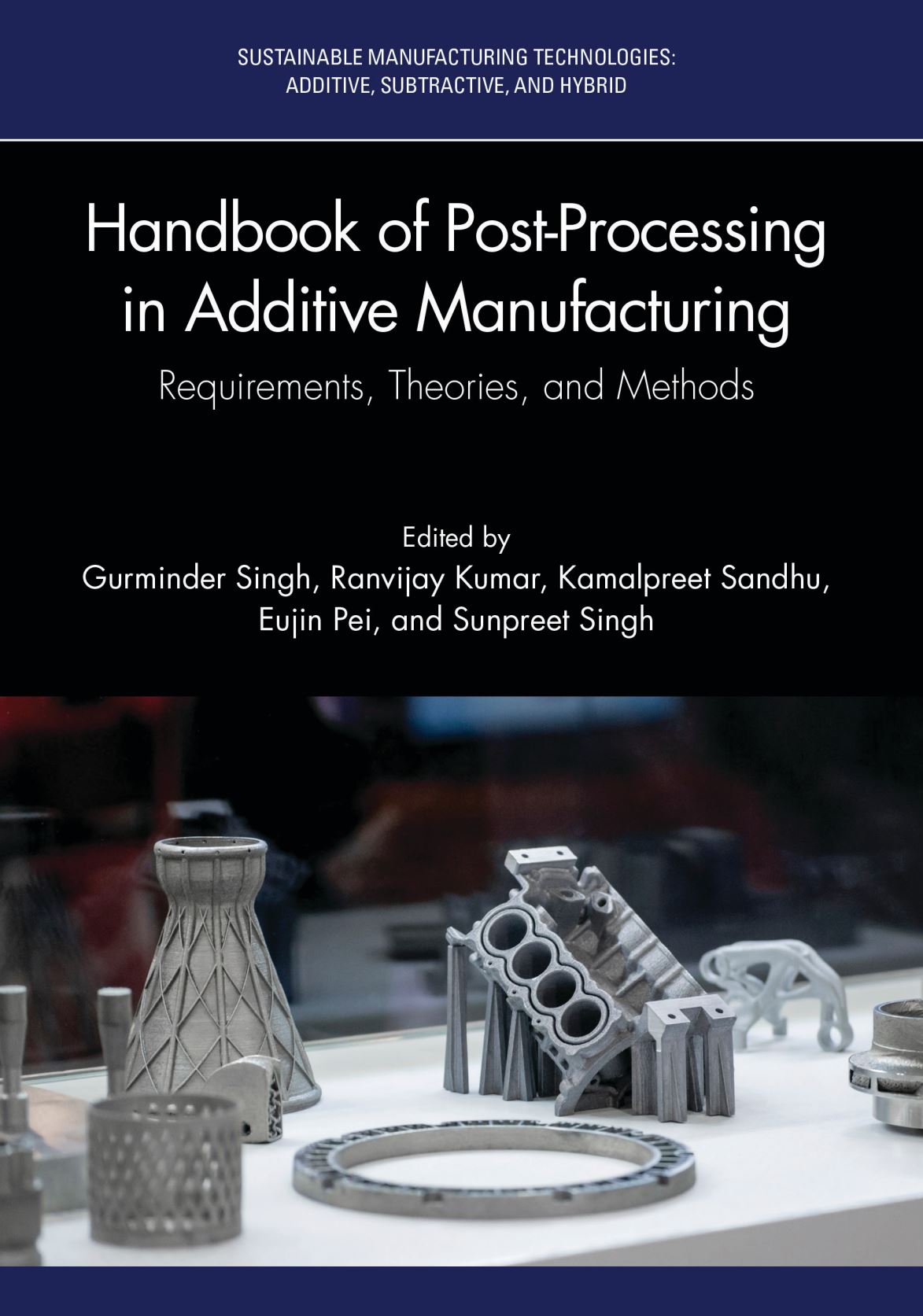Handbook of Post-Processing in Additive Manufacturing – Part 2

Handbook of Post-Processing in Additive Manufacturing
See the new book, edited by Gurminder Singh, Ranvijay Kumar, Kamalpreet Sandhu, Eujin Pei, Sunpreet Singh.
Description: Handbook of Post-Processing in Additive Manufacturing is a key resource on postprocessing treatments available for additive manufactured products. It provides broad coverage of the theory behind emerging technology, material development, functional characterization, and technical details required to investigate novel applications and methods and put them to use.
The handbook presents experimental breakthroughs of novel methodologies that treat additively manufactured parts, which are suitable for demanding engineering applications. This handbook emphasizes the various types of post-processing technologies that can effectively eliminate the inferiorities of additively manufactured components. It also provides a collection of key principles, literature, methodologies, experimental results, case studies, and theoretical aspects of the different types of postprocessing techniques, along with different classes of materials and end-applications.
This book is an ideal reference for libraries and post-graduate courses as well as the professional market, including, but not limited to manufacturing, mechanical and industrial engineering, and materials science.
Chapter 7
Additive manufacturing has several benefits, such as preparation of intricate geometrical shapes, ability to form lattice structures inside a component to reduce its weight, less wastage of material, and less cost. Aerodynamic performance, e.g., for turbine blades or vanes through interaction of the boundary layer of air flowing along the surface and resulting into flow instabilities. The conventional-type additive post-processing, e.g., as pneumatic spray coating, needs a high amount of material to be coated. A schematic of three conical towers with circular disks on top. From left to right, the labels are ultrasonic atomization, vibrating ultrasonic top, and droplet form. The electroplating process is a simple process that is recently used in many sectors, including electronic manufacturing and jewelry and for the preparing the metal layers and finishes. In the sputtering process, bombardment of high-energy particles causes the atoms from the material to come out from a target.
Coating/Cladding Based Post-Processing in Additive Manufacturing, By Rashi Tyagi, Ashutosh Tripathi, Book, Handbook of Post-Processing in Additive Manufacturing, Edition1st Edition, First Published 2023, ImprintCRC Press, Pages 15, eBook ISBN9781003276111
Chapter 10
Additive manufacturing (AM) is a promising method for engineering products because of its high dimension accuracy, high deposition rate, and capability for producing materials economically with improved physical and mechanical properties. AM consists of various methods, such as polyjet modeling (PJM), fused deposition modeling (FDM), multijet printing (MJP), selective laser sintering (SLS), and selective laser melting (SLM). Achieving high-quality products for all types of AM methods has been critical. Challenges of the quality characteristics faced in AM can be introduced as surface quality, molten-pool quality, and defects in final products. In addition, the microstructural and mechanical properties of the AM parts should also be considered as quality characteristics. This chapter introduces challenges of the quality characteristics in AM and reviews the properties of final AM products.
An Overview of the Quality Characteristics Challenges in Additive Manufacturing, By B. Özbay Kısasöz, A. Kısasöz
Book, Handbook of Post-Processing in Additive Manufacturing, Edition1st Edition, First Published 2023, ImprintCRC, Press, Pages 12, eBook ISBN9781003276111
Chapter 11
The material utilized in additive manufacturing (AM), a thermoplastic polymer, is highly machinable. AM plastics’ use, unattended garbage disposal, and exosystemic effects would all contribute to the continued environmental degradation. Our groundwater and soil are becoming contaminated as a result of the leakage of microplastics from plastic parts made with additives. Recycled engineered plastic is more important than ever for the environment. The biodegradability of components generated from three-dimensionally printed acrylonitrile butadiene styrene (ABS) is improved by the current research. Waste components are recycled by using atypical drilling processes, such as ABS acetone vapor jet drilling. As a result, this chapter includes a variety of research and analysis that demonstrates the economic and environmental benefits of continuing to use creative and hybrid post-processing for additively generated parts.
Innovative and Hybrid Post Processes for Additively Manufactured Parts, By Shahbaz Juneja, Jasgurpreet Singh Chohan, Raman Kumar, Arun Kumar, Sushant Kumar, Book, Handbook of Post-Processing in Additive Manufacturing, Edition1st Edition, First Published 2023, ImprintCRC Press, Pages 9, eBook ISBN9781003276111
See the full book here
Singh, G., Kumar, R., Sandhu, K., Pei, E., & Singh, S. (Eds.). (2023). Handbook of Post-Processing in Additive Manufacturing: Requirements, Theories, and Methods (1st ed.). CRC Press. https://doi.org/10.1201/9781003276111
There will be to addtional articles here soon with the remaining book chapter contents:

